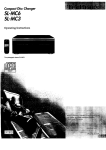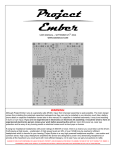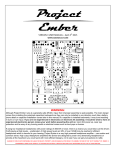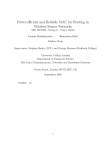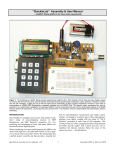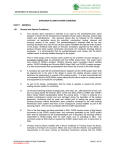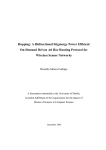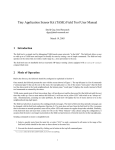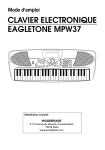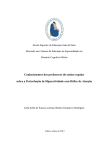Download Message Ferry Architecture and Implementation
Transcript
Message Ferry Architecture and Implementation Master’s Project Report Tammara Massey Georgia Institute of Technology April 28, 2004 Introduction Motivation In complex networks that contain a large variety in the density of the nodes, it is difficult to provide reliable and efficient service. In sparse areas of the network, the mobility of the nodes, the limited range of wireless communication, and physical factors such as severe weather partition the network These network outages are an unacceptable dilemma in networks that require reliability. Message Ferrying is a proactive routing algorithm created to address network partitions in sparse networks by establishing non-randomness. Message Ferrying is a proactive routing algorithm that incorporates message ferries or mobile nodes that carry messages among disconnected nodes [21]. Even though the network may contain sparse regions, the ferry may become a point of collision as all of the nodes try to connect and send information to the ferry. This problem will be more evident in the ad hoc regions of the network that are densely populated with nodes. The embedded devices, iPAQ and Smart Badge, are concerned with power and battery life. The most efficient way to save power is to have less hardware or more efficient hardware. In this distributed-memory infrastructure that uses message passing, the nodes only transmit to the ferry when the ferry is within range. Therefore, the nodes spend a lot of unnecessary energy maintaining the network interface, even when there is no one sending or receiving information. In order to save power, a small sensor / radio was added to the infrastructure. A radio / sensor was added to the ferry to broadcast a ferry message. Another radio / sensor was added onto the embedded application to sense when the ferry is nearby. When the ferry is detected, the sensor / radio turns on its network interface, and sends the information. After the exchange of information, the network interface turns off again. My objective is to implement the Message Ferry Algorithm on some embedded devices minimizing collisions on the ferry and minimizing power usage on the embedded device. The Message Ferrying Algorithm was created by a doctoral student called Wenrei Zhao. The power usage was minimized using an idea of a doctoral student at Georgia Tech called Hyewon Jun. Related Work Message Ferrying is a proactive routing algorithm that incorporates message ferries that allow communication among disconnected nodes. Ferries travel in a specified route, collecting data from sources and delivering data to the appropriate destinations. These message ferries allow nodes to communicate when the network is disconnected and when nodes do not have global knowledge of the network [21]. This algorithm is a good solution for sensor networks that may have several densely disconnected sections that need to communicate with one another. The underlying operating system used in many sensor networks was pioneered by TinyOS. This smart dust is a tiny event driven operating system that provides multiple flows of data from a single microcontroller [7]. With the emergence of advanced hardware and small operating systems, such as TinyOS, new types of sensor networks began to appear. A less fine grained mote was used in ZebraNet to track wildlife for biology research. This ad hoc peer to peer network was energy-efficient and reliable as it used GPS to track Zebras movements in the wild by using collars with sensors. A history based protocol that intelligently selected nodes based on prior communication patterns proved to satisfy the tradeoffs between storage, bandwidth, and energy requirements. This study was important because it demonstrated how to forward data in regions where there is not any widely deployed telecommunications support [6]. Another study called DataMULE addressed the problem of sparse area networks by using a similar infrastructure that Message Ferrying uses. Mobile entities called MULEs pick up data from sensors and drop off the data at wired access points. DataMULE takes a layered approach and contains three tiers of WAN connected devices, mobile agents, and sensor nodes. The MULE has low power requirements, low infrastructure cost, and large storage capacities. However, the MULE experiences high latency [16]. DataMULE differs from Message Ferrying because it uses static sensors and does not use proactive movement to deliver data. Another study that address power management in sensor networks is Mate. Mate, a tiny virtual machine for sensor networks, addresses the problem reprogramming failing nodes in an energy efficient manner [10]. The emergence an intelligent sensor network called Sensor Web that was capable of performing autonomous operation in uncertain environments. Sensor Webs are unique because they have pods that gather information and shared the information with neighboring pods. The collected data influences the behavior of these mobile pods and allows for more efficient collection of data. It also provides heterogeneous communication within the Sensor Web by allowing different kinds of pods to be added to the network [4] [5]. Another study that addresses communication among heterogeneous devices is iMASH (Interactive Mobile Applications Sessions Handoff) Project. iMASH created an architecture for fast, secure wireless communication across heterogeneous client devices and networks. iMASH utilized semantic savepointing, middleware only handoff, and content adaptation to allow heterogeneous communication in a wireless network. First, semantic savepointing identifies the essential state that needs to be sent for delivery. Then in middleware handoff, the middleware server initiates the handoff of data resulting in a lower latency time. Finally, only client appropriate data is delivered to the client application through content adaptation [3]. Another study that also uses intelligent reasoning in a sensor network is PlantCare. LaMarca designed a ubiquitous computing infrastructure that was usable, easily configurable, and required no user intervention. Self-maintained robots were built to automatically water plants using information on light, humidity, and temperature gathered from wireless sensors [9]. This study was important because it demonstrated the importance of continuous, automated service with no user intervention. Design Programming the Ad Hoc Message Ferrying Code The application created is a text messaging system that allows short messages to be passed back and forth between users. A simple implementation of Message Ferrying was implemented using ad hoc networking. A problem encountered when programming in ad hoc network is how to do the network address translation (NAT) from the IP address to the MAC address. In infrastructure mode, the base station contains the NAT and does the conversion. To overcome this problem, I used raw socket programming. Raw socket programming bypasses the TCP/IP layer and sends data by using the MAC address. A Master’s Student at Georgia Tech named Johnny Franslay had done previous work with RAW socket programming and Message Ferrying. Johnny’s functions for opening the sockets and sending information provided the basic infrastructure for my communication. UDP was chosen instead of TCP because TCP with slow start and the three way handshake make initialization and setup a slow process. With message ferrying, the ferry can be traveling at a high speed and may only have a few seconds to connect to the ad hoc network and transmit data. The time it takes for the ferry to join the network will cut into the time for the message to be passed. Also, it has been proven from simulations that TCP throughput drops a lot with node movement. The throughput decreases because the movement of the nodes causes link failures. TCP cannot distinguish the difference between congestion and link failure. Therefore, when a links fails, TCP believes it is congestion and reduces its congestion window and in the instance of a timeout, starts backing off its retransmission timeout (RTO) [8]. Due to these problems, TCP was not used in the implementation of Message Ferrying. In my code, I implemented a simple flow of control. The ferry first begins broadcasting out messages to the nodes. The broadcast interval is set to two seconds. The node however will not be able to receive the beacon because it has its network interface card off. The network interface card is off because it is assumed that the ferry is not within range. The ferry contains a ferry signal transmitter and the node contains a ferry signal receiver. The ferry signal generator notifies the ferry signal receiver that the ferry is near. When the ferry signal receiver receives the signal, it brings up it network interface card and begins to listen for the ferry broadcast signal. When the node received the beacon it replies back with information about its MAC address and that it is ready to receive data. If the ferry has data to send to the node, it sends it. When all data is sent, it sends a Ferry Done Message to the node. The node then sends data if it has data to send. When the node it finished, it sends a Node Done Message to the Ferry. The Ferry ends the communication by sending an ACK. The node is multithreaded and is continuously running the main program and is listening. The node is either listening for the ferry sensor to turn on its network card or the node is listening for the ferry beacon to open up a channel of communication. The main node program provides the user with three basic tasks. The user can compose a message by pressing “c”. The user can print out all messages already composed and waiting to be sent by pressing “p”. The user can also quit by pressing “q”. When messages are received they are also displayed on the screen. The messages are stores in queues. After the flow of control was implemented, an additional problem arose. The ferry experienced congestion and collisions when the nodes sent out data to the ferry. When the ferry broadcasted out the message, all the nodes received it at the same time. They all simultaneously sent their packets to ferry which resulted in collisions. To combat this problem, a scheduler was implemented on all the nodes. When the nodes were initialized they all received a random number. When they wanted to send information to the ferry, they waited for the specified random time before sending the data. This desynchronized the traffic flow and resulted in fewer collisions. Future work for Message Ferrying would be to implement different versions, such as Node Initiated Message Ferrying (NIMF) and Ferry Initiated Message Ferrying (FIMF). In these versions, the location and the destination of the node and the ferry would have to be tracked. Selecting and Programming the Sensor Hardware I investigated different types of sensor and radio technologies to optimize the embedded application that would run on a smart badge. I investigated several types of sensors / radios: GPS, Infrared, Active RF ID, CMOS, the Berkeley Mote, solar power, laser radar, and transmitter/receivers. GPS was unacceptable because one has to know the route of the ferry at all times and it was very expensive to implement. Infrared had a very low transmission rate. Laser radar needed a clear line of site and would be blocked by building and, therefore, was an unacceptable technology. CMOS, Solar powered sensors, and Active RFid were either expensive or hard to attain. Primarily, I choose a simple transmitter / receiver because it was easily accessible and was the most basic, affordable, and attainable hardware candidate. A simple transmitter / receiver can be found in any garage door opener. However, upon purchasing the hardware, it was discovered that the transmitter / receiver consumed a large amount of power (12V). After some further investigation, I then decided to use Berkeley motes. The Berkeley motes have a large communication range of 250 feet. They not only have a transmitter and receiver, but the kits came with many additional sensors. They were also affordable for our experiment because they could be loaned from the Systems Group Lab. However, the Berkeley mote kit is sold for approximately $500 from Crossbow and would not be a very cheap implementation for mass production. The Berkeley Mote has three parts: a processor board, a sensor board, and a programming board. I attained four Mote Processor Radio Boards (MPR), two Mote Interface Programming Boards (MIB), and four sensor boards (Figure 1). The sensor board is a MTS310CA and contains a light sensor, a temperature sensor, an acoustic sensor, a sounder sensor, a 2-axis accelerometer, and a 2-axis magnetometer. The processor board that is used to program the processor is a MDA500CA data acquisition board that provides a flexible user-interface for connecting external signals to the mote. The processor board is a MPR400CA. The MPR400CA uses an Atmel ATmega 128L microprocessor which runs TinyOS from its internal flash memory. This microprocessor can run the sensor processing and radio / network communication stack simultaneously. Figure 1: Mote Interface Programming Board, Mote Processor Radio Boards, and a Sensor Board. Our architecture only requires two MPRs, but some testing of the radio communications require three MPRs. Also, the sensor boards were used for testing of MPR communication, but were not used in the actual experiment. Both Mote Interface Programming Boards (MIB) worked correctly. Some additional hardware modifications had to be done to the motes. The antenna had to be soldered on to the MPRs. . In running the experiments, we also have to take into consideration the Smart Badge itself. The Smart Badge shown in Figure 2 is the device that will have its network interface turned on and off. The Berkeley motes are the actual sensing device that detects when the ferry is close and turns on the network interface. Smart Badges are experimental sensor platforms that run embedded Linux. Smart Badges consists of 32-bit StrongArm SA1110 processors, StrongArm1111 coprocessor, Flash, SDRAM, sensors, built in communication links, a SO-DIMM socket, PCMCIA interface, and a Compact Flash interface. Figure 2: Front Side of Smart Badge4 The documentation for the TinyOS and NesC, the programming language is not good. NesC is a new structured component-based language primarily used for embedded systems, such as sensor networks. In addition to learning a new programming language, other difficulties had to be overcome. First, the wrong version of the software was included with the Crossbow TinyOS CD. It included the software and instructions for Mica hardware, whereas I have Mica2 hardware. Also, a printer cable was used when downloaded the code to the mote, but the COM1 port was used when communicating with the smart badge. Many environmental variables in odd files had to be changed because Mica2 runs at 57.5K baud and the sensor board is a micasb not a basicsb. The basicsb is the sensor board for the more generic Berkeley motes. A Makelocal file had to be created to set the power to 916MHz and set the group ID. The group ID in the message header allows several groups of motes to share the same radio channel. After these interesting difficulties were overcome, I wrote the program for the ferry sensor in NesC to communicate as in the below diagram (Figure 3). Figure 3: Communication Architecture Between Two Mote Sensors and a Base Mote Experimental Results Berkeley Mote Experiments I modified two things in the Berkeley mote: the transmission power and the duty cycle. The transmission power affects the range of the ferry sensor. The range of the ferry sensor is directly proportional to how much power the sensor will use. The longer the range, the more power the sensor will use. Therefore, I performed two power adjustments to the sensor. To extend the range of communication, I also modified the network’s communication to include multi-hop routing. In multi-hop routing, one sensor broadcasts out to other sensors that the ferry is within range (Figure 4). Multi-hop communication is especially useful in architectures where the sensors have a low Sensor Ferry Single Hop Smart Badge Sensor Smart Badge Sensor Smart Badge Multi -Hop Multi -Hop Figure 4 Single and Multi-hop Routing in Message Ferrying transmission range because multi-hop communication will increase the amount of time the device has to communicate with the ferry. Our particular ferry sensor is the Berkeley Mote with a very long range of 250 feet. Therefore, we did not implement multi-hop communication. However, this data will be useful in future implementations where the price of the ferry sensor must be cheap. During the analysis of different types of sensors, I discovered that the range of the sensor was inversely proportional to how much the sensor cost. Figure 5 illustrates how higher transmission powers result in a longer communication range. Data in this graph was collected from the MPR /MIB User manual [12]. Some preliminary tests were done with the mote to verify its communication range. At the lowest setting, the MPR should have a range of 10 feet. However, the mote still transmitted at the maximum range of our experiment of 25 feet. Variation in Communication Range Caused by Transmission Power Communication Range (feet) 350 300 250 200 150 100 50 0 -25 -20 -15 -10 -5 0 5 10 Transmission Power (dBm) Figure 5: Affect of Transmission Power on Radio Range The speed of the ferry also affects the connectivity time between the device and the ferry. The sensor must be able to detect the ferry in time for the node to connect to the ferry and send information. If the range is not long enough, then the node will not have enough time to connect and finish transmission before it is out of range. A study was done by Ott and Kutsher with Wireless LAN communication and automobiles. In their experiments, they proved that a single access point had a reach of at least 200 meters in diameter with one IEEE 802.11b access point. Also, they concluded that the coverage obtained from a How the Speed of the Ferry Affects Throughput Throughput (Kbps) 200 150 100 50 0 0 10 20 30 40 50 Miles per Hour Throughput (1250 byte packets) Figure 6: Speed of the Ferry and Throughput 60 single access point is more than ten seconds, even at high speeds of 180 km/hr. They state that it takes 300ms for 1250 bytes of data to be sent and received. The beacon that detected the automobile had an interval of one second [13]. Using this information from the above study, I calculated the throughput in relation to speed in Figure 6. The assumption was used that packets of 1250 byte packets were used and that there was no congestion in the network. However, in our experiment the maximum packet size is 5000 byte packets, so results may vary. The transmission power is programmable and controlled by the PA_POW register. There are three main components on the board in Figure 8 that consume power: the processor, the radio, and the data logger. The processor is an Atmel ATmega 128L. The radio runs at frequency of 916 MHz. The data logger is a 4M-bit serial FLASH for storing data and measurements. The serial FLASH / Logger component can store over 100,000 measurements. I measured power of the entire board. I investigated also measuring the three main components on the board. However, the chips on the board were not set up to allow me to measure the power consumption without major changes to the MPR board. In order to measure the power consumption on the MPR board the wires connecting to the battery had to be cut and modified to allow me to attach it to a multimeter. I used a Craftsman 82002 Multimeter for this experiment. The results of the transmission power experiment done on single and multi-hop routing is shown in Figure 7. Power Consumption Due to Transmission Power 70 Power (mW) 60 50 Single Hop Routing 40 Multi-hop Routing 30 No LEDS 20 10 0 -20 -10 0 Output Power (dBm) Figure 7: Power Utilization for a Berkeley Mote with Varying Transmission Powers I also adjust the power by adjusting the duty cycle in the single hop communication architecture. Duty cycle is the proportion of time in which the device is operated. The more a component is used the quicker it will wear out. In regards to power, lowering the duty cycle reduces the power as seen in Figure 8. When measuring the power with Analysis of Power Utilization with Varying Duty Cycles Power (mW) 25 20 15 10 5 0 0.00% 20.00% 40.00% 60.00% 80.00% 100.00% Duty Cycle Low High Figure 8: Power Utilization for a Berkeley Mote using Varying Duty Cycles varying duty cycles, there was an observation made that the numbers fluctuated on the multimeter. This was due to the fact that the processing would be reduced during the inactive part of the cycle and then jump up during the active part of the cycle. Therefore, there is a high and a low value for the testing of the duty cycle. The multimeter would read the low for the majority of the time and shoot up to the high when the processor became busy. As the duty cycle was lowered, the range between the high and the low increased. However, adjusting the duty cycle does have some negative affects on the data rate. As the can be seen in Figure 9, decreasing the duty cycle reduces the data rate [19]. Affect of Duty Cycle on Packet Rate Data Rate (kbps) 50 40 30 20 10 0 0% 20% 40% 60% 80% 100% Duty Cycle (Percentage) Max Packet Rate Effective Packet Rate Figure 9: Duty Cycle Modes and Their Corresponding Data Rates Data used in the diagram was obtained from the TinyOS Tutorial. Therefore, in our application we should be cautious when lowering the duty cycle to ensure that we can still maintain our desired throughput. Embedded Device Experiments In order to determine the effectiveness of the ferry sensor, Hyewon, Jeonghwa, and I performed several different experiments on the embedded device. The amount of power the ferry sensor uses is drained from the Smart Badge. Therefore, minimizing the power that the ferry sensor uses will minimize the power of the entire application. Figure 10 shows how much power is used on the smart badge with and without the ferry sensor in the application. The longer the lifetime of the ferry sensor, the more time the network interface mode would be off. Power Utilization on the SmartBadge with Hardware Optimization Power (mW/min) 600000 500000 400000 300000 200000 100000 0 0 200 400 600 800 1000 Route time (minutes) Original Message Ferrying Hardware Optim ization Figure 10: Power of Smart Badge With and Without The Ferry Sensor. The latency to resume the network interface was also measure. The ferry broadcast message interval was reduced to 5 µseconds. Therefore, the latency measured would be dominated by how long it took to resume the interface, not by the period of the broadcasted message. As shown in Figure 11 and Table 1, the average latency to resume the wireless interface is only 237 µseconds. Since the latency is very small, it will probably have little to no effect on the throughput of the device. Figure 11. The Normal Distribution Of Resuming Latency In Ad Hoc Mode. Resume Latency of the Smart Badge and Berkeley Mote Mean latency 237.230 msec Standard deviation 21.655 Table 1: The Mean Latency and Standard Deviation of Resume Latency in Ad Hoc Message Ferrying Conclusion As can be seen from the results, using the ferry will save a considerable amount of power in the smart card. The larger the route of the ferry, the more power is saved. Also, it can be concluded that changing the transmission power had little affect on the power utilization in both the single and multi-hop experiments. This may be due to the fact that the Berkeley mote was specifically designed to save power and a lot of power optimizations in regards to transmission power have already been done. Therefore, it would be beneficial to use the highest transmission level to communicate in the Message Ferry Architecture. From these transmission experiments, it can be ascertained that the utilization of the LED lights had an affect on the power utilization. The utilization went up and down in the graphs. This was due to the fact that the green LED light was toggled off and on with each transmission. An explanation for why the transmission power did not change the power of the badge could be that it was because the function to control the transmission power is not implemented correctly in the TinyOS Kernel. The command Pot and SetTransmission Power were implemented on the lowest setting and it still had a range of over 25 feet instead of 10 feet. TinyOS still has bugs and the Transmission Power may not be implemented correctly in the code. The particular sensor that we used was the Berkeley Mote. The Berkeley was affordable in our particular case because they were borrowed from another research group. However, the MPR costs $150 dollars and the MIB cost $95 dollars. Crossbow is a new company selling the Berkeley motes. As the market expands, the cost for the Berkeley Mote components will become more affordable. Another alternative is to use a sensor with a lower range and use multi-hop routing. Using multi-hop routing will aid in extending the range of the ferry, but more studies need to be done to quantify the exact relationship this would have on distance. At a first glance, it seems that multi-hop routing uses more power than single hop routing in the transmission range experiment. But upon analyzing the LED light, it can be seen that more LED lights were used in multi-hop routing. Green and red lights were used to display the hop count on the MPR. When the lights were turned off and the power measured, it was the same power as single hop routing. Therefore, multi-hop routing did not use more power than the single hop routing and is recommended as an optimization in the Message Ferry architecture. A change in power could be seen by the duty cycle. However, one must be cautious when modifying the duty cycle in order to ensure that the throughput is enough to get the data to the ferry before it goes out of the range. Therefore, the specific application needs to be analyzed when determining to adjust the duty cycle. Optimizations made on the Berkeley mote had little affect on the overall power savings. Modifications to the transmission power resulted in no change in the power. Modifications to the duty cycle did enhance power savings, but at the cost of throughput. The maximum amount of power that could be saved by adjusting the duty cycle on the Berkeley mote was only 15mA. 15mA is only 2% of the total power of the device when it is active and 6% of the device when it is inactive. If the application requires high throughput, the duty cycle should not be optimized because the power savings are very low in comparison to the entire device’s energy consumption. The ferry sensor saves a considerable amount of power. The Smart Badge without the ferry sensor uses 590mW when idle and 604mW when transmitting data. The Smart Badge with the ferry sensor uses 240mW of power when idle and 604 mW when transmitting data. This is a considerable power savings. The power savings increases with the lifetime of the embedded device. Appendix Technical Details on Using the iPAQ Code ran on the iPAQ has to be compiled on a specific arm-linux compiler. The compiler must be downloaded in the root directory. The version that was used was 3.3.1. To download the compiled code onto the iPAQ, I had to connect the iPAQ through a serial cradle to a COM port in a laptop or PC. Minicom and Teraterm should then be used and the download should be done using the ZModem. The source and destination directories and the baud rate of 115200 must be specified in Minicom. I had difficulties with the Minicom application in Linux and used Teraterm. When compiling, I used the downloaded directory of /usr/local/arm/3.3.1/bin/gcc in the Makefile. Also, ensure that the iPAQ is running the orinoco_cs module and not the wavelen_cs module for the network driver. The wavelen_cs module has bugs and has been discontinued. Technical Details on Using the Smart Badge Code ran on the Smart Badge had to be compiled on a specific arm-uclibc compiler. This compiler must also be downloaded in the root directory. The version that was used was 3.2. To program and download code onto the Smart Badge, a COM cord was used while running Teraterm. The power supply must also be connected to the badge for it to function properly. The sensor drivers must be loaded with the command modprobe badge4_sensors. NFS must be running on the machine running as the server where the code is compiled. The Smart Badge is mounted with the command mount –o rw,nolock,intr 192.168.1.220:/home/badge0 /opt/Badge4. 192.168.1.220 is the IP address of the server. /home/badge0 is the directory on the server where the code is changed and can be compiled. Opt/Badge4 is the directory on the badge where the information will be stored. The code is compiled by typing arm-uclibc-gcc filename.txt. Technical Details on Using the Berkeley Mote Code ran on the Berkeley Mote had to be compiled using the TinyOS software. The code written was in an embedded C language called NesC. The version used for this experiment was 1.1 and the Motes used were Mica2. To compile the code the command make mica2 is used. To download the code onto the mote, the command make mica2 install. When setting up the software many variables must be changed and set. Ensure that the baud rate is set to 57.5K, the sensor board is set for micasb when using mica2 motes, and that a Makelocal file is created to set the power to 916MHz and set the group ID. The group ID in the message header allows several groups of motes to share the same radio channel. Check to ensure that the software and instructions match each other and also the actual motes that you received. The software did not match the motes on the Crossbow CD. Also, a printer cable should be used to download the code to the mote and the COM1 port should used when communicating with the smart badge. The COM1 cable requires a female to female connection. Recommendation for Future Message Ferrying Lab I recommend using some of these embedded technologies in future research with Message Ferrying. The three embedded devices that I used would be good for testing different types of wireless communication. The iPAQ is especially useful due to its lightweight size and portability. The Berkeley Motes were excellent in developing a wide variety of applications. The Berkeley Motes contain a light sensor, a temperature sensor, an acoustic sensor, a sounder sensor, a 2-axis accelerometer, and a 2-axis magnetometer. They are also portable and use very low power as can be seen from our experiments. The Smart Badge 4 is also a good embedded platform for sensors with a stronger processor than the Berkeley motes. Sensors, such as accelerometers, biometrics, and imaging sensors, may also be connected to the Smart Badge. It supports audio processing, such as speech, noise cancellation, and streaming audio. Video streaming and VoIP can also be done on the Smart Badge. Also, more complex versions of Message Ferrying involved tracking location. GPS tracks location but only outside and the measurements are not very precise. Another suggestion is to use laser radar. Laser radar has a range of 100 meters. The angle that the beam is reflected back to the source is calculated to tell the destination of the other entity. However, a clear line of site is required and any type of obstruction such as a building will not allow this type of technology to work. In addition to this deficiency, laser radar is quite expensive ranging from $200 – $3000. Acknowledgements I would like to thank Professor Hutto for loaning the Berkeley Motes for this Experiment. I would also like to thank Johnny Franslay whose raw socket functions for Message Ferrying were used in my Ad Hoc message ferrying code. Johnny also aided with technical help on the iPAQs and WLAN. I would like to thank Hyewon Jun for suggesting the power savings hardware optimization and also programming the serial port information. I would like to thank Professor Mark Smith from Hewlett Packard Labs for loaning me the Smart Badge and also aiding with power measurements on the Smart Badge and Berkeley Motes. I would also like to thank Jeonghwa Yung who programmed Infrastructure Message Ferrying on the Smart Badge (this application is not covered in this report.) References [1] I. Akyildiz, W. Su, Y. Sankarasubramaniam, and E. Cayirci, "Wireless Sensor Networks: A Survey," Computer Networks Journal, Vol. 38, no. 4, pp. 393-- 422, 2002. [2] M. Ammar and et al. “Report of NSF Workshop on Fundamental Research in Networking.” NSF Workshop on Fundamental Research in Networking, Airlie, Viginia, April 2003. [3] R. Bagrodia and etc. “iMASH: Interactive Mobile Application Session Handoff.” In Proceeding of MobiSys, May 2003. [4] K. Delin and S. Jackson. "The Sensor Web: A New Instrument Concept." In the Proceedings of the SPIE Symposium on Integrated Optics, San Jose, CA, January 2001. [5] K. Delin. "Sensor Web: A Macro-Instrument for Coordinated Sensing." In Sensors, Vol. 2, 2002, pp. 270-285. [6] P. Juang and et al. “Energy-efficient Computing for Wildlife Tracking: Design Tradeoffs and Early Experiences with ZebraNet. In the Proceedings of International Conference on Architectural Support for Programming Languages and Operating Systems (ASPLOS), San Jose, CA, October 2002. [7] J. Hill and et al. "System Architecture Directions for Networked Sensors." In the Proceedings of International Conference on Architectural Support for Programming Languages and Operating Systems (ASPLOS), Cambridge, MA, November 2000. [8] G. Holland and N. Vaidya. "Analysis of TCP Performance over Mobile Ad Hoc Networks." In the Proceedings of ACM/IEEE International Conference on Mobile Computing and Networking (MobiComm). Seattle, Washington. August 1999. [9] A. LaMarca, and etc. “Plantcare: An Investigation in Practical Ubiquitous Computing Systems”, In Proceedings of Ubicomp 2002, pp. 316-332, Goteborg, Sweden, Sep. 2002. [10] P. Lewis and D. Culler. "Mate: A Tiny Virtual Machine for Sensor Networks." In the Proceedings of International Conference on Architectural Support for Programming Languages and Operating Systems (ASPLOS), San Jose, CA, October 2002. [11] R. Mancini. "Instrumentation: Sensors to A/D Convertors." Op Amps for Everyone. Texas Instruments, 2nd ed. Dallas, Texas: Newnes, 2003. 12.1 - 12.23. [12] “MPR / MIB Mote User’s Manual”. Crossbow Technology, Inc. San Jose, California. 2003. [13] J. Ott and D. Kutscher. "Drive-thru Internet: IEEE 802.11b for 'Automobile' Users." In Proceedings of InfoComm. Hong Kong, China. March 2004. [14] P. Pirjanian, T.L. Huntsberger, and P. S. Schenker, "Development of CAMPOUT and Its Further Applications to Planetary Rover Operations: A Multirobot Control Architecture," In Proc. SPIE Sensor Fusion and Decentralized Control in Robotic Systems IV, Vol. 4571, Newton, MA, Oct. 28-29, 2001. [15] P.S. Schenker, P. Pirjanian, T.L. Huntsberger, A. Trebi-Ollennu, H. Aghazarian, P.C. Leger, JPL; S. Dubowsky, MIT; G.T. McKee, Univ Reading (UK), "Robotic intelligence for space: Planetary surface exploration, task-driven robotic adaptation, and multirobot cooperation," In Proc. SPIE Symposium on Intelligent Robots and Computer Vision XX: Algorithms, Techniques, and Active Vision, Vol. 4572, Newton, MA, Oct 29-31, 2001. [16] R. Shah and et al. "Data MULEs: Modeling a Three-tier Architecture for Sparse Sensor Networks." In Proceedings of the IEEE Workshop on Sensor Network Protocols and Applications (SNPA), Anchorage, AK, May 2003 [17] J. Singh and etc. "Wireless LAN Performance Under Varied Stress Conditions in Vehicular Traffic Scenarios." In the Proceedings of IEEE Vehicular Technology Conference. Vol. 2, Vancouver, Canada. September 2002. [18] A. Sipitakiat. "Making Sensors." GoGo Board. Rev. 0.91. http://learning.media.mit.edu/projects/ gogo/new/documents/making%20sensors.html. [19] Tiny OS Tutorial. “MICA2 Radio Stack for TinyOS.” [20] H. Zeng and et al. "ECOSystem: Managing Energy as a First Class Operating System Resource." In the Proceedings of International Conference on Architectural Support for Programming Languages and Operating Systems (ASPLOS), San Jose, CA, October 2002. [21] W. Zhao and M. Ammar, "Message Ferrying: Proactive Routing in Highly-Partitioned Wireless Ad Hoc Networks." In Proceedings of the 9th IEEE Workshop on Future Trends in Distributed Computing Systems, Puerto Rico, May 2003. [22] W. Zhao and M. Ammar. "A Message Ferrying Approach for Data Delivery in Sparse Mobile Ad Hoc Networks." To appear in MobiHoc, Tokyo, Japan, May 2004.


















